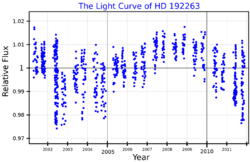Astronomy:HD 192263
| Observation data Equinox J2000.0]] (ICRS) | |
|---|---|
| Constellation | Aquila[2] |
| Right ascension | 20h 13m 59.8456s[3] |
| Declination | −00° 52′ 00.770″[3] |
| Apparent magnitude (V) | 7.79[2] |
| Characteristics | |
| Spectral type | K1/2 V[4] |
| B−V color index | 0.938±0.015[2] |
| Variable type | BY Draconis variable[5] |
| Astrometry | |
| Radial velocity (Rv) | −10.67±0.09[2] km/s |
| Proper motion (μ) | RA: −62.730(23)[3] mas/yr Dec.: 260.819(17)[3] mas/yr |
| Parallax (π) | 50.9432 ± 0.0230[3] mas |
| Distance | 64.02 ± 0.03 ly (19.630 ± 0.009 pc) |
| Absolute magnitude (MV) | 6.36[2] |
| Details[6] | |
| Mass | 0.65±0.09 M☉ |
| Radius | 0.74±0.02 R☉ |
| Luminosity | 0.295+0.014 −0.013 L☉ |
| Surface gravity (log g) | 4.51 cgs |
| Temperature | 4,955 K |
| Metallicity [Fe/H] | +0.08 dex |
| Rotational velocity (v sin i) | 2.1 km/s |
| Age | 6.6+4.7 −4.4 Gyr |
| Other designations | |
| Database references | |
| SIMBAD | data |
| ARICNS | data |
| Extrasolar Planets Encyclopaedia | data |
HD 192263 is a star with an orbiting exoplanet in the equatorial constellation of Aquila. The system is located at a distance of 64 light years from the Sun based on parallax measurements,[3] and is drifting further away with a radial velocity of −10.7 km/s.[2] It has an absolute magnitude of 6.36,[2] but at that distance the apparent visual magnitude is 7.79.[2] It is too faint to be viewed with the naked eye, but with good binoculars or small telescope it should be easy to spot.
The spectrum of HD 192263 matches a K-type main-sequence star, an orange dwarf, with a stellar classification of K1/2 V[4] This is a BY Draconis variable, with variations in luminosity being caused by star spots on a rotating stellar atmosphere.[1] It has a high level of magnetic activity in its chromosphere. The star is being viewed almost equator-on, with a projected rotational velocity of 2 km/s.[8] It has 65% of the mass of the Sun, 74% of the Sun's radius, and is roughly 6.6 billion years old. The star is radiating 30% of the luminosity of the Sun from its photosphere at an effective temperature of 4,955 K.[6]
The star HD 192263 is named Phoenicia. The name was selected in the NameExoWorlds campaign by Lebanon, during the 100th anniversary of the IAU. Phoenicia was an ancient thalassocratic civilisation of the Mediterranean that originated from the area of modern-day Lebanon.[9][10]
Various companions for the star have been reported, but all of them are probably line-of-sight optical components or just spurious observations.[citation needed]
Planetary system
On 28 September 1999, an exoplanet around HD 192263 was found by the Geneva Extrasolar Planet Search team using the CORALIE spectrograph on the 1.2m Euler Swiss Telescope at La Silla Observatory,[11] discovered independently by Vogt et al.[12] The exoplanet is named Beirut after the capital and largest city of Lebanon.[9][10]
| Companion (in order from star) |
Mass | Semimajor axis (AU) |
Orbital period (days) |
Eccentricity | Inclination | Radius |
|---|---|---|---|---|---|---|
| b / Beirut | >0.641±0.61 MJ | 0.15312±0.00095 | 24.3587±0.0022 | 0.008±0.014 | — | — |
See also
- List of exoplanets discovered before 2000 - HD 192263 b / Beirut
References
- ↑ 1.0 1.1 1.2 Dragomir, Diana et al. (2012). "The HD 192263 System: Planetary Orbital Period and Stellar Variability Disentangled". The Astrophysical Journal 754 (1). doi:10.1088/0004-637X/754/1/37. Bibcode: 2012ApJ...754...37D.
- ↑ 2.0 2.1 2.2 2.3 2.4 2.5 2.6 2.7 Anderson, E.; Francis, Ch. (2012), "XHIP: An extended hipparcos compilation", Astronomy Letters 38 (5): 331, doi:10.1134/S1063773712050015, Bibcode: 2012AstL...38..331A.
- ↑ 3.0 3.1 3.2 3.3 3.4 Vallenari, A. et al. (2022). "Gaia Data Release 3. Summary of the content and survey properties". Astronomy & Astrophysics. doi:10.1051/0004-6361/202243940 Gaia DR3 record for this source at VizieR.
- ↑ 4.0 4.1 Houk, N.; Swift, C. (1999), "Michigan catalogue of two-dimensional spectral types for the HD Stars", Michigan Spectral Survey (Ann Arbor, Michigan: Department of Astronomy, University of Michigan) 5, Bibcode: 1999MSS...C05....0H
- ↑ Samus, N. N. et al. (2017), "General Catalogue of Variable Stars", Astronomy Reports, GCVS 5.1 61 (1): 80–88, doi:10.1134/S1063772917010085, Bibcode: 2017ARep...61...80S.
- ↑ 6.0 6.1 Brewer, John M. et al. (2016), "Spectral Properties of Cool Stars: Extended Abundance Analysis of 1,617 Planet-Search Stars", The Astrophysical Journal Supplement Series 225 (2): 32, doi:10.3847/0067-0049/225/2/32, Bibcode: 2016ApJS..225...32B.
- ↑ "HD 192263". SIMBAD. Centre de données astronomiques de Strasbourg. http://simbad.u-strasbg.fr/simbad/sim-basic?Ident=HD+192263.
- ↑ Santos, N. C. et al. (2003). "The CORALIE survey for southern extra-solar planets XI. The return of the giant planet orbiting HD 192263". Astronomy and Astrophysics 406 (1): 373–381. doi:10.1051/0004-6361:20030776. Bibcode: 2003A&A...406..373S.
- ↑ 9.0 9.1 "Approved names" (in en). http://www.nameexoworlds.iau.org/final-results.
- ↑ 10.0 10.1 "International Astronomical Union | IAU". https://www.iau.org/news/pressreleases/detail/iau1912/.
- ↑ Santos, N. C. et al. (2000). "The CORALIE survey for Southern extra-solar planets III. A giant planet in orbit around HD 192263". Astronomy and Astrophysics 356: 599–602. Bibcode: 2000A&A...356..599S. https://articles.adsabs.harvard.edu/pdf/2000A%26A...356..599S.
- ↑ Vogt, Steven S. et al. (2000). "Six New Planets from the Keck Precision Velocity Survey". The Astrophysical Journal 536 (2): 902–914. doi:10.1086/308981. Bibcode: 2000ApJ...536..902V.
External links
- Henry; Donahue, Robert A.; Baliunas, Sallie L. (2002). "A False Planet around HD 192263". The Astrophysical Journal Letters 577 (2): L111–L114. doi:10.1086/344291. Bibcode: 2002ApJ...577L.111H. http://www.iop.org/EJ/article/1538-4357/577/2/L111/16461.html.
- "HIP 99711". SIMBAD. http://webviz.u-strasbg.fr/viz-bin/VizieR-S?HIP%2099711.
- "CCDM 20140-0052". SIMBAD. http://webviz.u-strasbg.fr/viz-bin/VizieR-S?CCDM%20J20140-0052A.
- "HD 192263". wikisky.org/ wikisky.org. http://server6.wikisky.org/starview?object_type=1&object_id=1310256&object_name=HD+192263&locale=EN.
- "TABLE,"X/H" VALUES FOR HD 134987, 168443, 192263, 209458, 217014, 217107, AND 222582". IOP Electronic Journals. http://www.iop.org/EJ/article/1538-3881/121/1/432/200400.tb9.html.
- "Image HD 192263". SIMBAD. http://aladin.u-strasbg.fr/AladinPreview?-c=LTT++8003&ident=LTT++8003&submit=Aladin+previewer.
Coordinates: ![]() 20h 13m 59.8451s, −00° 52′ 00.757″
20h 13m 59.8451s, −00° 52′ 00.757″
 |


